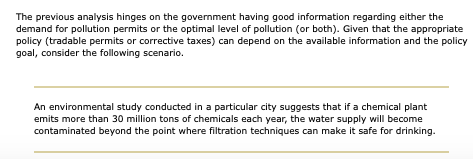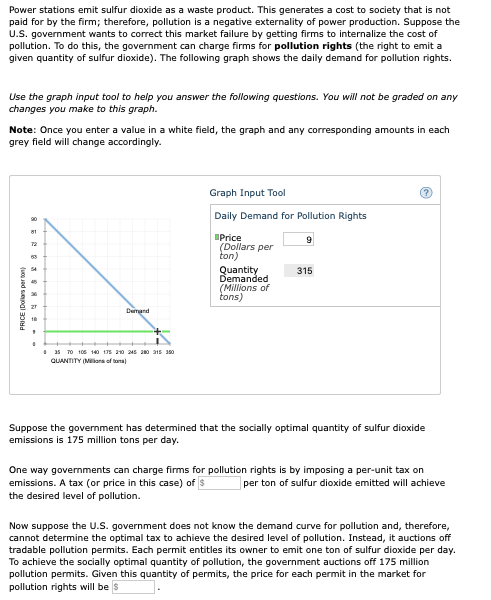Power stations emit sulfur dioxide as a waste product. This generates a cost to society that is not paid for by the firm; therefore, pollution is a negative externality of power production. Suppose the U.S. government wants to correct this market failure by getting firms to internalize the cost of pollution. To do this, the government can charge firms for pollution rights (the right to emit a given quantity of sulfur dioxide). The following graph shows the daily demand for pollution rights. Use the graph input tool to help you answer the following questions. You will not be graded on any changes you make to this graph. Note: Once you enter a value in a white field, the graph and any corresponding amounts in each grey fleld will change accordingly. Graph Input Tool Daily Demand for Pollution Rights Price (Dollars per ton) Quantity Demanded (Millions of tons) 315 Dunand QUANTITY (Mona of Suppose the government has determined that the socially optimal quantity of sulfur dioxide emissions is 175 million tons per day. One way governments can charge firms for pollution rights iis by imposing a per-unit tax on emissions. A tax (or price in this case) of s the desired level of pollution. |per ton of sulfur dioxide emitted will achieve Now suppose the U.S. government does not know the demand curve for pollution and, therefore, cannot determine the optimal tax to achieve the desired level of pollution. Instead, it auctions off tradable pollution permits. Each permit entitles its owner to emit one ton of sulfur dioxide per day. To achieve the socially optimal quantity of pollution, the government auctions off 175 million pollution permits. Given this quantity of permits, the price for each permit in the market for pollution rights will be s (uod sngi 30
Power stations emit sulfur dioxide as a waste product. This generates a cost to society that is not paid for by the firm; therefore, pollution is a negative externality of power production. Suppose the U.S. government wants to correct this market failure by getting firms to internalize the cost of pollution. To do this, the government can charge firms for pollution rights (the right to emit a given quantity of sulfur dioxide). The following graph shows the daily demand for pollution rights. Use the graph input tool to help you answer the following questions. You will not be graded on any changes you make to this graph. Note: Once you enter a value in a white field, the graph and any corresponding amounts in each grey fleld will change accordingly. Graph Input Tool Daily Demand for Pollution Rights Price (Dollars per ton) Quantity Demanded (Millions of tons) 315 Dunand QUANTITY (Mona of Suppose the government has determined that the socially optimal quantity of sulfur dioxide emissions is 175 million tons per day. One way governments can charge firms for pollution rights iis by imposing a per-unit tax on emissions. A tax (or price in this case) of s the desired level of pollution. |per ton of sulfur dioxide emitted will achieve Now suppose the U.S. government does not know the demand curve for pollution and, therefore, cannot determine the optimal tax to achieve the desired level of pollution. Instead, it auctions off tradable pollution permits. Each permit entitles its owner to emit one ton of sulfur dioxide per day. To achieve the socially optimal quantity of pollution, the government auctions off 175 million pollution permits. Given this quantity of permits, the price for each permit in the market for pollution rights will be s (uod sngi 30
Economics (MindTap Course List)
13th Edition
ISBN:9781337617383
Author:Roger A. Arnold
Publisher:Roger A. Arnold
Chapter30: Market Failure: Externalities, Public Goods, And Asymmetric Information
Section: Chapter Questions
Problem 10QP
Related questions
Question

Transcribed Image Text:The previous analysis hinges on the government having good information regarding either the
demand for pollution permits or the optimal level of pollution (or both). Given that the appropriate
policy (tradable permits or corrective taxes) can depend on the available information and the policy
goal, consider the following scenario.
An environmental study conducted in a particular city suggests that if a chemical plant
emits more than 30 million tons of chemicals each year, the water supply will become
contaminated beyond the point where filtration techniques can make it safe for drinking.

Transcribed Image Text:Power stations emit sulfur dioxide as a waste product. This generates a cost to society that is not
paid for by the firm; therefore, pollution is a negative externality of power production. Suppose the
U.S. government wants to correct this market failure by getting firms to internalize the cost of
pollution. To do this, the government can charge firms for pollution rights (the right to emit a
given quantity of sulfur dioxide). The following graph shows the daily demand for pollution rights.
Use the graph input tool to help you answer the following questions. You will not be graded on any
changes you make to this graph.
Note: Once you enter a value in a white field, the graph and any corresponding amounts in each
grey field will change accordingly.
Graph Input Tool
Daily Demand for Pollution Rights
81
IPrice
(Dollars per
ton)
Quantity
Demanded
(Millions of
tons)
72
63
315
Demand
35 70 106 140 175 210 245 0 215 190
QUANTITY (Mlons of tons
Suppose the government has determined that the socially optimal quantity of sulfur dioxide
emissions is 175 million tons per day.
One way governments can charge firms for pollution rights is by imposing a per-unit tax on
emissions. A tax (or price in this case) of s
the desired level of pollution.
|per ton of sulfur dioxide emitted will achieve
Now suppose the U.S. government does not know the demand curve for pollution and, therefore,
cannot determine the optimal tax to achieve the desired level of pollution. Instead, it auctions off
tradable pollution permits. Each permit entitles its owner to emit one ton of sulfur dioxide per day.
To achieve the socially optimal quantity of pollution, the government auctions off 175 million
pollution permits. Given this quantity of permits, the price for each permit in the market for
pollution rights will be s
(uog ed sogl 3d
Expert Solution
This question has been solved!
Explore an expertly crafted, step-by-step solution for a thorough understanding of key concepts.
This is a popular solution!
Trending now
This is a popular solution!
Step by step
Solved in 2 steps with 1 images

Knowledge Booster
Learn more about
Need a deep-dive on the concept behind this application? Look no further. Learn more about this topic, economics and related others by exploring similar questions and additional content below.Recommended textbooks for you

Economics (MindTap Course List)
Economics
ISBN:
9781337617383
Author:
Roger A. Arnold
Publisher:
Cengage Learning


Exploring Economics
Economics
ISBN:
9781544336329
Author:
Robert L. Sexton
Publisher:
SAGE Publications, Inc

Economics (MindTap Course List)
Economics
ISBN:
9781337617383
Author:
Roger A. Arnold
Publisher:
Cengage Learning


Exploring Economics
Economics
ISBN:
9781544336329
Author:
Robert L. Sexton
Publisher:
SAGE Publications, Inc


Principles of Microeconomics (MindTap Course List)
Economics
ISBN:
9781305971493
Author:
N. Gregory Mankiw
Publisher:
Cengage Learning

Principles of Economics 2e
Economics
ISBN:
9781947172364
Author:
Steven A. Greenlaw; David Shapiro
Publisher:
OpenStax